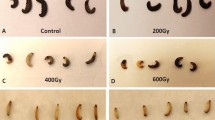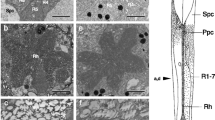Summary
-
1.
In order to interpret the results of experiments involving the injection of the ommochrome-precursor 3-hydroxykynurenine (3-HOK) into pupae of the red eyed strain and measurement of pigment synthesis (Muth, 1967, 1968), a model is proposed, based on the following assumptions:
-
a)
The presence of cytoplasmatic granules containing RNA is a necessary condition for pigment synthesis.
-
b)
The granules originate from preformed material, if the amount of 3-HOK rises in the presence of this material or if the amount of this material rises in the presence of the precursor. The amount of the material being transformed into granules depends on the value of the stationary and on the hight of the rise of the changed variable. The dependence on the precursor is such that the originating granules are saturated by the precursor.
-
c)
After a fast synthesis the preformed material becomes inactivated, regardless of whether having been transformed into granules or not. Though the amount of 3-HOK decreases, the rate of inactivation provides a lasting saturation of the granules.
-
a)
-
2.
The model allows the derivation of a function, which describes the dependence of the rate of ommochrome synthesis on the injected amount of the precursor.
-
3.
The composition of the pigment being synthesized depends on the injected dose. The results are consistent with the assumption that the pigment consists of 2 mixtures,A′ andB, the ratio of which,B∶:A′ rises with the injected dose.
-
4.
The experimentally obtained values of the mixtureA′ fit the function, calculated on the basis of the proposed model.
Zusammenfassung
-
1.
Zur Deutung der bei Injektionsversuchen erhaltenen Ergebnisse wird ein Modell vorgeschlagen, das auf folgenden Annahmen basiert:
-
a)
Notwendige Voraussetzung für die Pigmentbildung ist die Gegenwart ribonuclein-säurehaltiger cytoplasmatischer Granula.
-
b)
Diese Granula entstehen aus präformiertem Material dann, wenn entweder eine Erhöhung der Vorstufenmenge in Gegenwart dieses Materials erfolgt, oder wenn in Gegenwart der Vorstufe die Menge des präformierten Materials zunimmt. Die Menge des in Granula überführten Materials hängt vom Wert der stationären und der Grö\e der Erhöhung der veränderten Variablen ab. Die Abhängigkeit von der Vorstufe ist derart, da\ die entstehenden Granula mit der Vorstufe abgesättigt sind.
-
c)
Nach schnellem Aufbau wird dieses Material entsprechend seiner Menge wieder inaktiviert, gleichgültig, ob es bereits in Granula überführt worden ist oder nicht. Diese Inaktivierung erfolgt schnell genug, um trotz 3-HOK-Abnahme im Verzüge der Pigmentbildung stets eine Sättigung des aktiven Granulamaterials mit der Vorstufe zu gewährleisten.
-
a)
-
2.
Aus diesen Vorstellungen wird die analytische Gestalt einer Funktion hergeleitet, die es erlaubt, die Abhängigkeit der Rate von der injizierten Dosis zu errechnen.
-
3.
Die Zusammensetzung des Pigments ist dosisabhängig. Die Daten stehen in Einklang mit der Annahme, da\ das Pigment aus 2 Teilgemischen,A undB, besteht, deren Verhältnis,B∶:A, mit der Dosis steigt.
-
4.
Die für eine bestimmte Mischung ausA undB, das GemischA′, experimentell ermittelte Dosisabhängigkeit zeigt befriedigende übereinstimmung mit der aufgrund des Modells errechneten Funktion.
Similar content being viewed by others
Literatur
Becker, E.: über Eigenschaften, Verbreitung und die genetisch-entwicklungsphysiologische Bedeutung der Pigmente der Ommatin- und Ommingruppe (Ommochrome) bei den Arthropoden. Z. Vererbungsl.80, 157 (1942).
Butenandt, A.: Biochemie der Gene und Genwirkungen. Naturwissenschaften40, 91 (1953).
—,E. Biekert u.B. Linzen: über Ommochrome. VII. Mitt. Modellversuche zur Bildung des Xanthommatins in vivo. Hoppe Seylers Z. physiol. Chem.305, 284 (1956).
Caspari, E.: On the pigment formation in the testis sheath ofRt andrt Ephestia kühniella Zeller. Biol. Zbl.74, 585 (1955).
—, andI. Blomstrand: The effect of nuclear genes on the structure and differentiation of cytoplasmatic particles. Cold Spr. Harb. Symp. quant. Biol.21, 291 (1956).
—: A yellow pigment in the testis ofEphestia: Its development and its control by genes. Genetics43, 679 (1958).
—, andJ. Richards: Genie action. Yearbook Carnegie Inst.47, 183 (1948).
Egelhaaf, A.: über das Wirkungsmuster des „a“-Locus vonEphestia kühniella. Z. Vererbungsl.94, 349 (1963).
Fuge, H.: Die Pigmentbildung im Auge vonDrosophila melanogaster und ihre Beeinflussung durch denwhite +-Locus. Z. Zellforsch.83, 468 (1967).
Hanser, G.: über die Histogenese der Augenpigmentgranula bei verschiedenen Rassen vonEphestia kühniella Z. undPtychopoda seriata Schrk. Z. Vererbungsl.82, 74 (1948).
Joshi, S., andR. R. Brown: Pigment formation from hydroxykynurenine by a rat liver system. Fed. Proc.18, 255 (1959).
Kühn, A.: über den Ausfärbungsverlauf der Imaginalaugen vonEphestiagenotypen in der Puppe. Biol. Zbl.79, 385 (1960).
—: Die zeitliche Folge der Bildung der Ommochrome in den Imaginalaugen vonEphestia undPtychopoda. Z. Naturforsch.18b, 252 (1963).
—: Eine neue Mutation in der Ommochrombildungskette beiEphestia kühniella. Z. Naturforsch.12b, 728 (1957).
—, u.E. Becker: Quantitative Beziehungen zwischen zugeführtem Kynurenin und Augenpigment beiEphestia kühniella Z. Biol. Zbl.62, 303 (1942).
—, u.A. Egelhaaf:über die Mutationbr (braunäugig) beiEphestia kühniella. Z. Vererbungsl.90, 244 (1959).
Linzen, B.: über die Verbreitung der Ommochrome, der dunklen Augenpigmente der Arthropoden. Verh. Dtsch. Zool. Ges. Frankfurt. 1958, S. 154.
—: über Ommochrome XXIII. Ommidine — ein neuer Typus von Ommochromen aus Orthopteren. Z. Naturforsch.21b, 1038 (1966).
Maier, W.: Elektronenmikroskopischer Vergleich von Retinula-Pigmentzellen der Wildformwa + und der Mutantewa vonEphestia kühniella Z. Z. Naturforsch.20b, 311 (1965).
Muth, F. W.: Quantitative Untersuchungen zum Pigmentierungsgeschehen in den Augen der MehlmotteEphestia kühniella.I. Grundlagen. Wilhelm Roux' Arch. Entwickl.-Mech. Org.159, 379 (1967).
—: Quantitative Untersuchungen zum Pigmentierungsgeschehen in den Augen der MehlmotteEphestia kühniella. II. Die Pigmentbildung ima-Stamm nach Injektion kleiner Mengen von 3-Hydroxykynurenin. Wilhelm Roux' Archiv161, 336 (1968).
Nagasawa, H. T., andH. R. Gutmann: The oxydation of o-amino-phenols by cytochromec and cytochrome oxydase. I. Enzymatic oxydations and binding of oxydation products to bovine serum albumin. J. biol. Chem.234, 1593 (1959).
Osanai, M.: Tyrosinaseaktivität bei derHestina-Raupe zu Beginn der überwinterung. J. Insect Physiol.14, 261 (1968a).
—: Tyrosinaseaktivität in den Eiern von Ommochrom-Mangelmutanten des Seidenspinners,Bombyx mori. J. Insect Physiol.14, 403 (1968b).
Shoup, J. R.: The development of pigment granules in the eyes of wild type and mutantDrosophila melanogaster. J. Cell Biol.29, 223 (1966).
Wessing, A., u.A. Bonse: Natur und Bildung des roten Farbstoffes in den Nierentubuli der Mutante „red“ vonDrosophila melanogaster. Z. Naturforsch.21b, 1219 (1966).
—, u.R. Danneel: Speicherung von Oxykynurenin in den Malpighischen Gefä\en verschiedener Augenfarbenmutanten vonDrosophila melanogaster. Z. Naturforsch.16b, 388 (1961).
Ziegler, I., u.L. Jaenicke: Zur Wirkungsweise deswhite-Allels beiDrosophila melanogaster. Z. Vererbungsl.90, 53 (1959).
Author information
Authors and Affiliations
Rights and permissions
About this article
Cite this article
Muth, F.W. Quantitative Untersuchungen zum Pigmentierungsgeschehen in den Augen der MehlmotteEphestia kühniella . W. Roux' Archiv f. Entwicklungsmechanik 162, 56–77 (1969). https://doi.org/10.1007/BF00581546
Received:
Issue Date:
DOI: https://doi.org/10.1007/BF00581546




